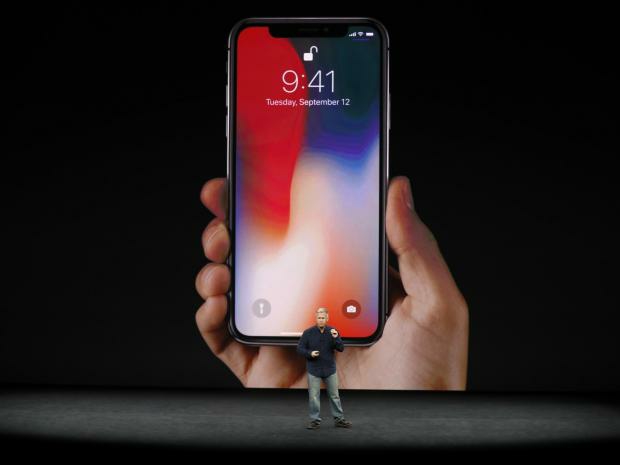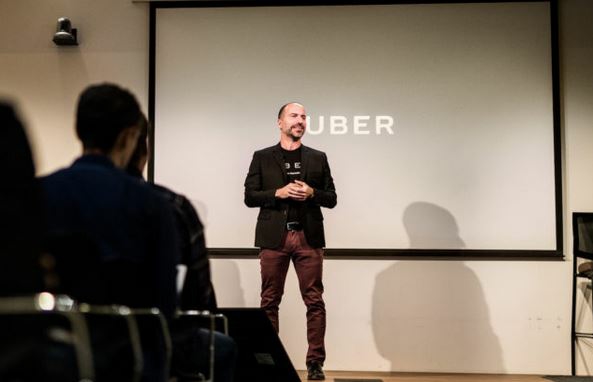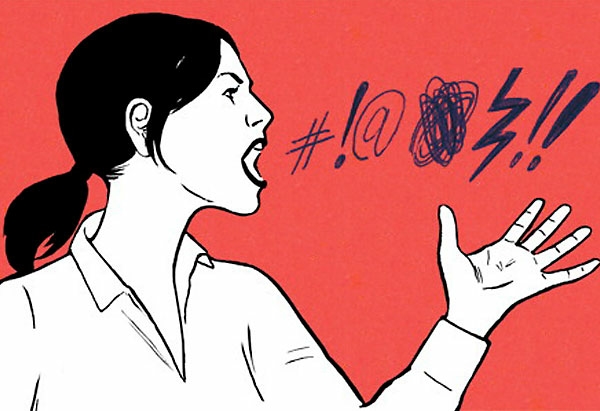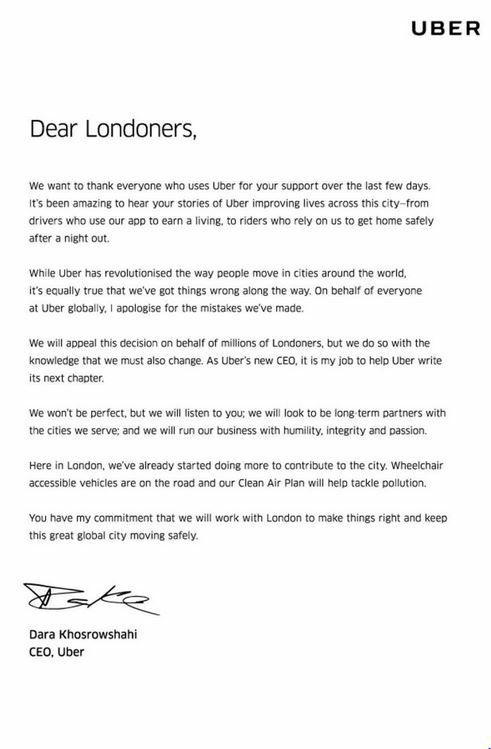How Bad Was Theresa May's Speech?
 The Telegraph calls it a "car crash" and "one of the most disastrous conference speeches in history." British Prime Minister Theresa May faced three problems in front of the Conservative Party Conference in Manchester.
The Telegraph calls it a "car crash" and "one of the most disastrous conference speeches in history." British Prime Minister Theresa May faced three problems in front of the Conservative Party Conference in Manchester.
First, a protestor interrupted the speech to hand her a "P45," which is a document used to fire workers in the U.K. (Sounds like a "pink slip" in the U.S.) The prankster was escorted out, and May recovered by making a joke: "I was about to talk about someone I'd like to give a P45 to, and that's Jeremy Corbyn," who is the leader of the Labour Party.
Then, she had a coughing fit and had to drink a glass of water, some of which seemed to spill into her hand. (Here, I'm reminded of Marco Rubio's odd sip of water.)
Finally, captions dropped a letter, leaving "for" as "or." The Telegraph and other media outlets reported this mishap as "the stage falls apart," but I would say that's quite an exaggeration.
Discussion:
- I think the media outlets were too harsh. Do you agree? Why or why not?
- This is a humbling experience for May. How well did she recover?
- What lessons can you take for your own presentations?
Netflix's Funny Cease-and-Desist Letter
Netflix got high marks for a funny legal letter, which I realize is typically an oxymoron. A pop-up bar in Chicago showed Stranger Things, which is against Netflix's policy. In response, the company's lawyer sent a cease-and-desist letter, giving the owners a generous six weeks before they need to stop playing episodes for customers.
This reminds me of the Jack Daniels letter in Chapter 5 of the book. Both show lawyers as human beings.
Discussion:
- What's the value of a more conversational legal letter? What are the downsides?
- The letter isn't perfect. Try to find the punctuation error.
- What makes this letter authentic?
Miracles Happen: An Apology from Uber
 The typically non-apologetic Uber is apologizing. Two factors likely caused the company's change: 1) a new CEO, and 2) losing its operating license in London.
The typically non-apologetic Uber is apologizing. Two factors likely caused the company's change: 1) a new CEO, and 2) losing its operating license in London.
The new CEO has already demonstrated his vulnerability by talking about his emotions and showing us more of who he is as a person. An article in The Guardian explains why the city decided not to renew the company's license, which expires September 30:
TfL [Tranport for London] said last week Uber was not a "fit and proper" private car-hire operator and cited four areas of concern, including its approach to reporting criminal offences and carrying out background checks on drivers. But sources close to TfL indicated that a change of conduct from the taxi firm, the culture of which is being reformed by its new chief executive, could leave the door open to a fresh licence application.
The London decision is a blow for the ride-sharing company, and Uber is doing what it can to rebuild its image.
London Mayor Sadiq Kahn responded to the apology:
"I welcome the apology from Dara Khosrowshahi, the Uber CEO. Obviously I am pleased that he has acknowledged the issues that Uber faces in London. Even though there is a legal process in place, I have asked TfL to make themselves available to meet with him."
Discussion:
- Assess Khosrowshahi's apology. What works well, and what could be improved? (Hint: What organization principles apply?)
- What is the value of an apology? In this case, how does Uber's apology help its position with London?
iPhone X Face ID Doesn't Work During Presentation
 During Apple's big presentation to unveil and show features of the iPhone X, the Face ID program didn't work.
During Apple's big presentation to unveil and show features of the iPhone X, the Face ID program didn't work.
The presenter, Craig Federighi, SVP Software Development, reacted briefly when the passcode screen came up. Then he said, "Let's try that again." He picked up another device, and the feature worked.
What happened? Verge reports that it probably wasn't a problem Face ID. Rather, the passcode screen came up as a precaution just as it would on earlier versions when you restart your phone or when you haven't used it for a few hours.
Still, it was tough moment for Federighi.
Things often go wrong during presentations but, as is the case for more serious company crises, how the situation is handled is sometimes remembered more than initial issue.
Discussion:
- How well did Federighi handle the situation? What, if anything, could he have done differently?
- Apple has been quiet on the issue. Should the company explain what happened? If so, in what form, and what should they say?
- In this small moment, do we see authenticity from Federighi? What does he tell us about who he is as a person?
Pastor Responds to Criticism
 Joel Osteen, senior pastor at Lakewood Church in Houston, Texas, has a large following, but he has taken a hit since Hurricane Harvey. Critics say Osteen should have offered his mega-church, which seats 16,8000, to people needing housing after the storm. Instead, Osteen tweeted his prayers, and people say it wasn't enough.
Joel Osteen, senior pastor at Lakewood Church in Houston, Texas, has a large following, but he has taken a hit since Hurricane Harvey. Critics say Osteen should have offered his mega-church, which seats 16,8000, to people needing housing after the storm. Instead, Osteen tweeted his prayers, and people say it wasn't enough.
Church officials said the building experienced "severe flooding," but pictures told a different story. In TV interviews, Osteen defended the church's practices. He said, "The main thing is, the city didn't ask us."
In an article on PR Daily, Brad Phillips raised the issue of authenticity:
If you're cynical about televangelists, Osteen's tone in the Today show interview probably struck you as smarmy and self-satisfied. If you're one of the millions of people who watch his sermons and read his books, you probably viewed him as sincere.
Phillips also questioned why the church didn't have plans in place and, specifically, why the leaders didn't coordinate with Houston city officials ahead of time.
The social media response has not been kind: memes abound.
Discussion:
- What's your view of the church's actions during and after the hurricane?
- How well did Osteen respond to criticism? What are his main arguments? Which are strongest, and which fall short?
- Given Phillips' question about Osteen's authenticity, how do you view his interview on the Today show?
- What's your view of the social media response and memes: cruel, justified, or something else?
- How do your own religious beliefs or practices influence your assessment of the situation and of Osteen, particularly?
Uber Announces New CEO
 Uber hired Expedia Chief Executive Dara Khosrowshahi to replace founder Travis Kalanick. Khosrowshahi is seen as a stable force, which is needed at Uber after many months of controversy. In addition to his role at Expedia, Khosrowshahi is on The New York Times board of directors.
Uber hired Expedia Chief Executive Dara Khosrowshahi to replace founder Travis Kalanick. Khosrowshahi is seen as a stable force, which is needed at Uber after many months of controversy. In addition to his role at Expedia, Khosrowshahi is on The New York Times board of directors.
The news was announced today in major newspapers, but as of 4:30 pm, the company hadn't posted a statement on its news site or on Twitter. A Bloomberg interview says the news is "still under wraps," although it was all over Twitter and other social media sites.
Finally, the company posted a message sent to employees from the board of directors:
Team,
We are delighted to announce that Uber's Board has voted unanimously to appoint Dara Khosrowshahi to be our new CEO.
Dara came to America at nine years old when his family escaped Iran on the eve of the Iranian Revolution. He grew up in Tarrytown, N.Y., trained as an engineer at Brown, and spent many years at IAC serving as Chief Financial Officer and in various operational and strategic roles.
In 2005, he became CEO of Expedia, which he built into one of the world's leading travel and technology companies, now operating in more than 60 countries. He has four children and not surprisingly loves to travel, one of his favorite trips being to the Angkor Wat temples in Cambodia where his wife Sydney said yes to marrying him.
We're really fortunate to gain a leader with Dara's experience, talent and vision. The Board and the Executive Leadership Team are confident that Dara is the best person to lead Uber into the future building world-class products, transforming cities, and adding value to the lives of drivers and riders around the world while continuously improving our culture and making Uber the best place to work.
Dara will be joining us tomorrow, August 30, for an All Hands. Add your questions for Dara here, and stay tuned for a calendar invite with more details. He'll also be meeting with employees around the world in smaller groups over the next few weeks, and spending time with drivers.
Please join us in welcoming Dara on what promises to be an exciting ride!
-Yasir, Garrett, Matt, Ryan, Arianna, Travis, Wan Ling & David
The message is unusually personal for a CEO introduction, drawing on Khosrowshahi's immigrant past and family life.
The website also now includes "Highlights from Today's Company Meeting," where Khosrowshahi was introduced and talked about himself, again, in a more personal way than we usually hear from a chief executive. He also says, several times, he's not about "B.S."
Discussion:
- Why would the company take this personal approach in introducing its new leader?
- Khosrowshahi clearly is trying to come across as authentic. Is he succeeding?
- When people say, "I am not going to B.S. you," I think that they will. To me, it's like saying, "I'll be honest with you." Why would you be anything else? Do you share this view or not?
CEOs Leave President Trump's Business Advisory Councils
 Several CEOs have left or were planning to leave President Trump's business advisory councils after his response to the Charlottesville, VA, incident. President Trump has been stalwart in blaming "both sides" of the protests in Charlottesville, which escalated in violence. For some CEOs, the response wasn't strong enough in condemning white supremacists. In a news conference, President Trump said there was violence among the liberal contingent as well as those wanting to, for example, defend confederate statues. He drew an analogy between George Washington and Thomas Jefferson, who owned slaves, with Robert E. Lee, who led the confederate army during the U.S. civil war.
Several CEOs have left or were planning to leave President Trump's business advisory councils after his response to the Charlottesville, VA, incident. President Trump has been stalwart in blaming "both sides" of the protests in Charlottesville, which escalated in violence. For some CEOs, the response wasn't strong enough in condemning white supremacists. In a news conference, President Trump said there was violence among the liberal contingent as well as those wanting to, for example, defend confederate statues. He drew an analogy between George Washington and Thomas Jefferson, who owned slaves, with Robert E. Lee, who led the confederate army during the U.S. civil war.
Merck chief executive Ken Frazier was the first to resign from the president's manufacturing council. Others filed suit, and still others planned to resign, including Indra Nooyi of Pepsi, Jamie Dimon of JP Morgan, Alex Gorsky of J&J, and Jeff Immelt of GE.
Doug McMillon, Walmart's chief executive, has been vocal and has faced criticism from Walmart customers. In a memo to employees, McMillion explained his position:
As we watched the events and the response from President Trump over the weekend, we too felt that he missed a critical opportunity to help bring our country together by unequivocally rejecting the appalling actions of white supremacists. His remarks today were a step in the right direction and we need that clarity and consistency in the future.
Our country is facing some very difficult issues that require our elected officials, business leaders and community-based organizations to work together. Representing a company with the largest and one of the most diverse groups of associates in the U.S., and an even more diverse customer base of tens of millions of customers, we believe we should stay engaged to try to influence decisions in a positive way and help bring people together. I will continue to strongly advocate on behalf of our associates and customers, and urge our elected officials to do their part to promote a more just, tolerant and diverse society.
Thank you for representing Walmart and our values today -- and every day.
Before another group, inspired by Nooyi of Pepsi, could resign, President Trump decided to disband all of his business advisory councils. The decision is a blow to the president, who prided himself on his business relationships when taking office.
Discussion:
- Did these business leaders do the right thing? Why or why not?
- What did it take for Merck's CEO to take the lead, and for Pepsi's CEO to inspire the next wave? What was at risk for both of them and for other CEOs?
- Besides addressing the Charlottesville situation differently, what could President Trump have done differently to maintain his relationships with these business leaders?
Should We Curse at Work?
 A book, What the F: What Swearing Reveals About Our Language, Our Brains, and Ourselves, explains why cursing is good for us. Author Benjamin K. Bergen also argues that cursing is a social construct: certain words are "bad" only because we say they are.
A book, What the F: What Swearing Reveals About Our Language, Our Brains, and Ourselves, explains why cursing is good for us. Author Benjamin K. Bergen also argues that cursing is a social construct: certain words are "bad" only because we say they are.
Cursing has some benefits. One study showed that swearing in response to an injury helps us tolerate pain. Another showed that swearing improved performance in bicycle and hand-grip exercises. Bergen argues that cursing allows people to show their emotional state instead of hiding it. He also says cursing brings people of similar backgrounds or cultures together.
But what about swearing at work? This seems to vary based on industry, company, and work group. Some cursing, such as ethnic slurs, are offensive and would rarely be tolerated. However, many teams will curse among themselves, depending on the relationships and circumstances.
Discussion:
- Do you curse? Why or why not? Under what circumstances would you curse or avoid it?
- How do you feel about cursing in professional work environments? What are the advantages and disadvantages?
WSJ Article Encourages Exotic Clothes for Networking
 Time to go shopping. A Wall Street Journal article profiles Pradeep Aradhya, a digital marketing executive and investor, about his approach to networking. He says that networking didn't come easy to him, but he now attends events for six to eight hours a week and finds ways to stand out.
Time to go shopping. A Wall Street Journal article profiles Pradeep Aradhya, a digital marketing executive and investor, about his approach to networking. He says that networking didn't come easy to him, but he now attends events for six to eight hours a week and finds ways to stand out.
Aradhya follows a model he learned to "entertain, enlighten or enrich" others. He also changed his wardrobe from traditional suits to "crushed silk or woven with metallic thread, and wears exotic-looking designer shoes." According to Aradhya, he doesn't always have to start conversations; often, people will comment on his unusual clothing. Another strategy is saying something shocking, such as introducing himself as the king of India.
An article in Career Ladders offers advice for networking attire. The recommendations sound prescriptive-based on the event, for example, a barbecue or a cocktail party. For women going to a cocktail party, for example, the article suggests the following:
Choose a cocktail dress that is flattering and exposes a tasteful amount of skin. No plunging necklines or bandage dresses, please. Look for a hem that grazes the knee - any longer, and you will look dated; any shorter, and you will look like you belong in a club. Dresses made in chiffon or silk lay nicer than satin, which tends to rumple in all the wrong places. A silhouette that flatters almost any women's body is sleeveless, with a scoop neck, fitted waist and slightly fuller skirt. Avoid fussy prints and stick to colors that translate well at night: black, gray, shades of red and navy. Wear open-toed heels and your favorite ear or neck sparklers for a finishing touch.
Compared to Aradhya's strategy, this is certainly a conservative approach.
Discussion:
- How do you balance presenting your "best self" and being authentic? Can you think of times when you felt inauthentic during a networking or another type of event? What were the circumstances, and what did you learn?
- How do you know what risks to take during networking? What's enough to distinguish you, and what's too much?
- How important do you think attire is during networking events? How difficult is it to overlook someone who isn't dressed for the part but may be a great business partner or hire?
Customer Service Gone Wrong
 An article in Ad Age details a scripted, annoying customer interaction at Chase bank. The customer waits on line for a teller and is encouraged to use an ATM instead (with a longer line). The conversation seems relentless:
An article in Ad Age details a scripted, annoying customer interaction at Chase bank. The customer waits on line for a teller and is encouraged to use an ATM instead (with a longer line). The conversation seems relentless:
"I can stand with you by the ATM and walk you through it -- it's really easy," he said.
Oh God. He was obviously working off some sort of script.
"Right, yeah," I said, "I've used them before. I'd just prefer to deal with a teller today." Head back down, eyes on my iPhone.
"Can I ask why?" (Oh jeez.)
The killer line was this rationale for using the machine: "You know, if you use one of the ATMs, you reduce stress for him [the teller]." Although the representative claimed the bank is adding tellers, it didn't take long for the writer to find headlines about Chase laying off 5,000 employees.
Encouraging people to use technology may be good for business, but customer service people need to read social cues to know when to end a conversation-and they should get the facts straight.
Discussion:
- Read the article for more detail. What verbal and body language cues did the bank representative miss?
- What should the rep have said or done differently? What would have made the interaction sound less "scripted"?
- Did the situation warrant the writer's reaction? Should he have simply done as suggested and used the ATM?
Uber CEO Tries to Change His Image
 After many stories of Uber's questionable practices with reporters, employees, drivers, and technology, CEO Travis Kalanick is trying to change his image. A Recode author writes, "A more cuddly Uber CEO Travis Kalanick has returned to social media."
After many stories of Uber's questionable practices with reporters, employees, drivers, and technology, CEO Travis Kalanick is trying to change his image. A Recode author writes, "A more cuddly Uber CEO Travis Kalanick has returned to social media."
After a Twitter hiatus in 2016, Kalanick is back on, as Recode reports, "as the nicest CEO in the whole wide world." We see pictures of Kalanick with his mom on Mother's Day, with his parents at the Kentucky Derby wearing hats, and of his grinning face while he touches his heart.
Recode reminds us this isn't the first time Kalanick has taken to social media to try to change the company's and his own image:
After the media furor around whatever scandal of the moment died down, Kalanick tried to humanize himself - and, by virtue, the company - and often turned to puppies or children to do that.
After we saw a video of Kalanick arguing with an Uber driver over declining wages, he promised to improve. But the promise was about his leadership style. This seems like a PR fix.
Discussion:
- Assess Kalanick's approach. Who is his audience, and what are his objectives?
- Am I justified in questioning Kalanick's sincerity or too harsh?
- What else could he do to improve the company's image and his own image?
Mall of America's Social Strategy
 PR Daily News reports on Mall of America's successful "newsjacking," or taking advantage of news stories to promote business. Being close to the Mineapolis-St. Paul International Airport gives the mall the chance to lure travelers to shop when their flight is delayed.
PR Daily News reports on Mall of America's successful "newsjacking," or taking advantage of news stories to promote business. Being close to the Mineapolis-St. Paul International Airport gives the mall the chance to lure travelers to shop when their flight is delayed.
Last summer, the mall wrote a blog post, "Flight delayed? 11 things to do at MOA," offering better options than wandering aimlessly like Tom Hanks in "The Terminal." Like a lot of malls these days (what's left of them), Mall of America is part amusement park.
Through social listening, the mall is responsive, but they also promote timely events, such as the mall's 25th anniversary, and greet people who announced celebrations at the mall. We can see the potential for creepiness here, but management believes people appreciate this.
The mall has a bunch of people writing posts, and manager Timothy Pate lets them have their own voice: "Mall of America happens to have a lot of quirky stories, and we aren't afraid to share those with our readers. We find when you really let your quirks shine through, readership goes up."
Discussion:
- From Chapter 3 in the text or from your own research, how would you define social listening?
- I mentioned the concern about "creepiness." Where should social media managers draw the line? What are some examples of overstepping?














